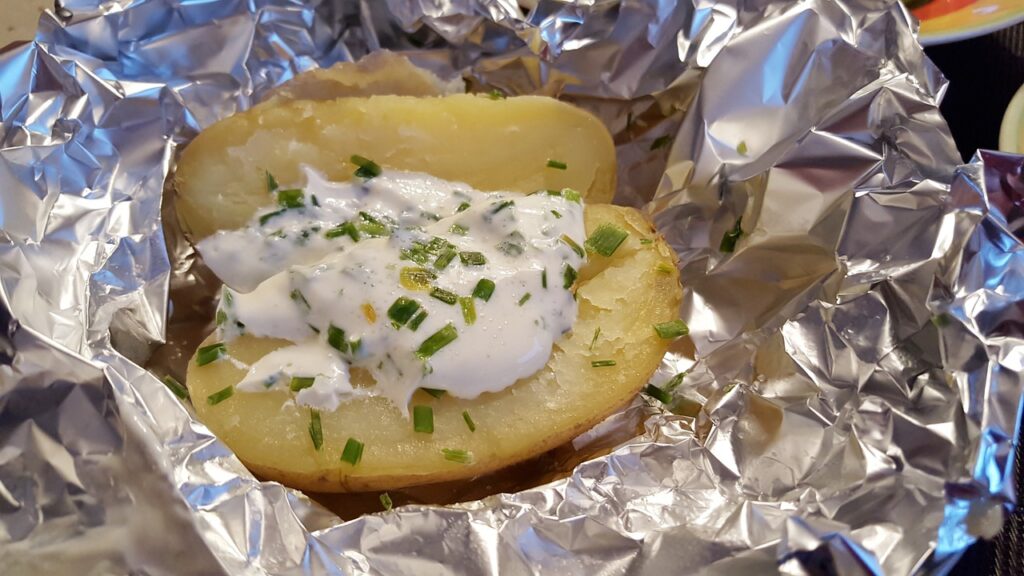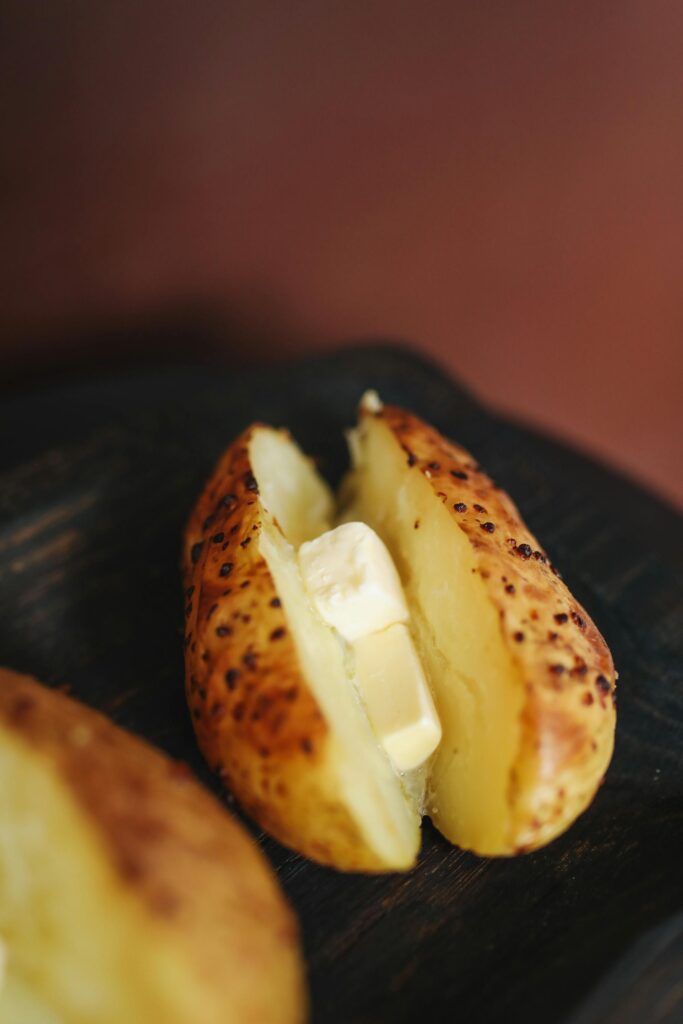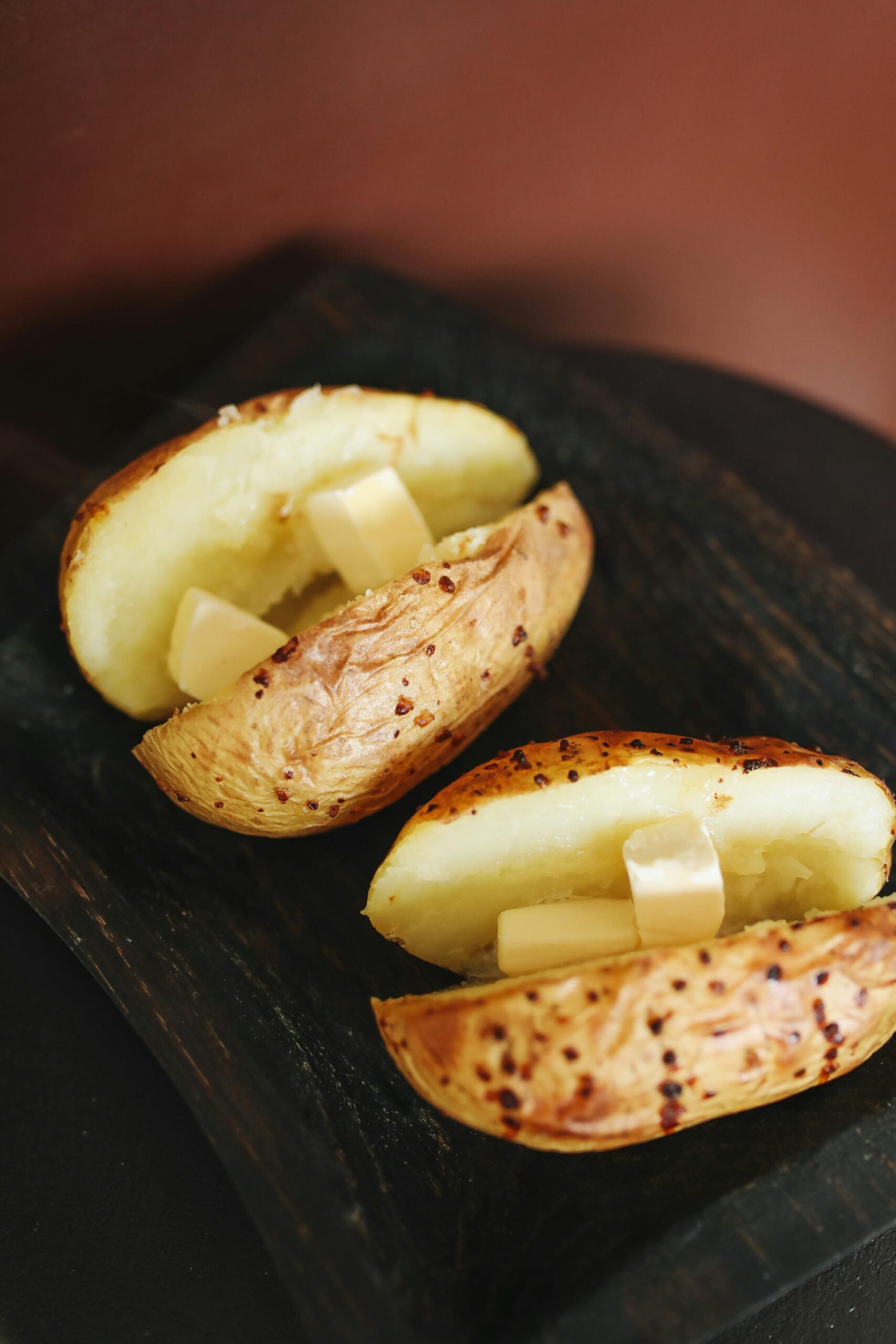Introduction:
This is a paragraph.
Would you believe that potatoes were once named as one of the most filling foods in a groundbreaking satiety study? I was amazed to learn that a medium baked potato contains only 110 calories – yet ranks higher in satiety than many “diet foods”! The European Journal of Clinical Nutrition found that boiled potatoes scored an impressive 323% on the satiety index, higher than any other food tested. Let’s explore why this humble vegetable might be your unexpected ally in weight loss!
Nutritional Benefits for Weight Loss
Let me share my journey exploring the nutritional side of weight management with bananas. While some people shy away from them during weight loss, there’s actually a fascinating science-backed story here that might surprise you.
You know what’s wild? I spent years avoiding bananas during my nutrition coaching days because I bought into that “too much sugar” myth. But after diving into the research and experimenting with clients, I discovered these yellow powerhouses pack some serious weight loss benefits that aren’t obvious at first glance.
Let’s talk specifics about calories and macros, because this is where things get interesting. A medium banana typically contains about 105 calories – not bad for something that can keep you full for hours. The macronutrient breakdown is what really caught my attention: about 27g of carbs, 1.3g of protein, and 0.4g of fat. But here’s the kicker – about 3.1g of that carb content is actually fiber, which your body processes completely differently from regular carbs.
Speaking of fiber, this is where bananas really shine for weight loss. The combination of soluble and insoluble fiber creates what I like to call the “fullness double-whammy.” The soluble fiber slows down digestion (hello, satiety!), while the insoluble fiber adds bulk without calories. I noticed this effect dramatically when I started having a banana with my morning protein shake – my mid-morning snack cravings practically disappeared.
Now, let’s geek out about resistant starch for a minute, because this is seriously cool stuff. Green or slightly underripe bananas contain higher amounts of resistant starch, which basically acts like fiber in your body. What blew my mind was learning that resistant starch actually feeds your gut bacteria, potentially boosting your metabolism. When these beneficial bacteria ferment the resistant starch, they produce compounds called short-chain fatty acids that might help with fat burning.
The potassium story is another game-changer for weight management. One medium banana packs about 422mg of potassium, and here’s why that matters: potassium helps regulate fluid balance and muscle contractions, which can reduce water retention and bloating. During my nutrition workshops, I’ve seen countless clients amazed at how adding potassium-rich foods like bananas helped their bodies release excess water weight.
Blood sugar impact is probably the most misunderstood aspect of bananas. While they do contain natural sugars, the fiber content creates a unique situation. The glycemic load of a medium banana is actually moderate – around 11, which surprised even me when I first learned about it. This means they typically won’t cause those dramatic blood sugar spikes that lead to energy crashes and cravings.
Here’s something practical I learned through trial and error: timing matters. Having a banana about 30 minutes before a workout provides just enough easily digestible carbs for energy, while the fiber helps prevent blood sugar crashes during exercise. I’ve found this especially helpful for my clients who work out in the morning.
Let’s talk about ripeness levels too, because this can significantly impact the nutritional benefits. As bananas ripen, their resistant starch converts to regular sugar. While riper bananas are easier to digest, slightly underripe ones might be better for weight loss due to their higher resistant starch content. I usually recommend my clients experiment with different ripeness levels to see what works best for their bodies.
The satiety factor really deserves extra attention here. In my experience working with weight loss clients, foods that provide sustained energy are worth their weight in gold. Bananas hit this sweet spot because of their unique combination of fiber, resistant starch, and natural sugars. Plus, they’re incredibly convenient – nature’s perfect portable snack!
Remember though, portion size still matters. While bananas are nutrient-dense, they’re still caloric. I always suggest starting with medium-sized fruits and adjusting based on your individual needs and goals. The key is finding that balance between enjoying their benefits and maintaining your caloric deficit for weight loss.

Optimal Preparation Methods
Let me share what I’ve learned about preparing bananas to maximize their health benefits – and boy, have I made some interesting discoveries through trial and error!
Remember when everyone thought just peeling and eating a banana was the only way to go? Well, after years of experimenting in my test kitchen and teaching cooking workshops, I’ve found that different preparation methods can actually unlock various nutritional benefits. It’s pretty fascinating stuff!
Let’s talk about cooking techniques first, because this is where things get really interesting. Boiling bananas might sound weird (I definitely raised my eyebrows the first time I heard about it), but it can actually increase their resistant starch content. I learned to simmer them for about 15-20 minutes in their peels – any longer and you’ll end up with banana mush. Trust me on this one, I learned that lesson the hard way!
Temperature control is absolutely crucial when cooking bananas. Through countless kitchen experiments, I’ve found that moderate heat (around 350°F/175°C) works best for baking or roasting. Higher temperatures can destroy some of the beneficial compounds, while too low temperatures won’t develop those lovely caramelized flavors we’re after.
Now, here’s something that totally blew my mind when I first learned about it: cooling cooked bananas can significantly increase their resistant starch content. It’s called retrogradation, and it happens when you let cooked bananas cool down completely before eating them. I started doing this with my morning banana oatmeal – cooking it the night before and letting it chill overnight. The difference in satiety was noticeable!
For nutrient retention, I’ve discovered some pretty effective tricks. Keeping the peel on during cooking acts like a natural barrier, protecting those precious nutrients inside. When baking, I always add a small splash of lemon juice – the vitamin C helps preserve the banana’s nutrients and prevents excessive browning.
Let me share some common mistakes I see people make (and definitely made myself when starting out). The biggest one? Overcooking. Bananas are delicate, and excessive heat can destroy their beneficial compounds. I used to bake them until they were super soft, but now I know better – you want them just tender enough to mash easily.
Another game-changer was learning about ripeness levels for different cooking methods. Green bananas are great for boiling and will give you the highest resistant starch content. For baking, those spotty, overripe bananas aren’t just good – they’re perfect! They contain more natural sugars and antioxidants.
Here’s a tip that revolutionized my banana bread game: if you’re baking with bananas, try roasting them in their peels first. Just pop them in the oven at 300°F for about 15-20 minutes until the peels are black. The natural sugars caramelize, creating this amazing depth of flavor. Plus, this method actually preserves more nutrients than traditional mashing.
Temperature cycling has become one of my favorite techniques. This involves cooking bananas, cooling them completely, then gently reheating them. Each cooling cycle increases the resistant starch content. I know it sounds like extra work (and honestly, I was skeptical at first), but the improved satiety effect makes it worth it.
When it comes to storage after cooking, I learned that airtight containers are your best friend. Cooked bananas oxidize quickly, which can lead to nutrient loss. I always let them cool completely before sealing them up – this prevents condensation that could lead to spoilage.
The key takeaway from all my kitchen adventures? Preparation method really does matter. Whether you’re after more resistant starch, better nutrient absorption, or just trying to make the perfect banana bread, how you prepare your bananas can make a huge difference in both nutrition and taste. And remember – don’t be afraid to experiment! Some of my best discoveries came from what I thought were kitchen mistakes.
Smart Topping Choices
Let me share what I’ve discovered about banana toppings after years of experimenting with different combinations in my nutrition workshops. Who knew such a simple fruit could become a complete meal with the right toppings?
I still remember the day I realized I’d been doing banana toppings all wrong. There I was, drowning my bananas in honey and wondering why my healthy snack wasn’t keeping me full! After diving deep into nutrition research and testing countless combinations, I’ve found some game-changing topping strategies that actually support weight loss goals.
Let’s talk protein toppings first, because this was a total revelation for me. A tablespoon of natural nut butter (about 95 calories) adds around 4g of protein and healthy fats that dramatically improve satiety. My personal favorite is unsalted almond butter – just remember to measure it! I used to eyeball portions and couldn’t figure out why my “healthy” snacks were sabotaging my clients’ progress.
Speaking of healthy fats, here’s something interesting I discovered: combining certain fats with bananas actually helps your body absorb their nutrients better. Hemp seeds (3 tablespoons = 170 calories) not only add omega-3s but also pack in 10g of protein! Just watch your portions – I learned the hard way that even healthy fats can quickly add up.
For those watching their calories closely, I’ve found some amazing low-cal flavor enhancers. A sprinkle of cinnamon (less than 2 calories) not only adds warmth but may help regulate blood sugar. Ground nutmeg or cardamom (about 1 calorie per pinch) can transform your banana into something that tastes surprisingly decadent.
Here’s my tried-and-true portioning strategy for toppings:
– Nut butters: stick to 1 tablespoon (95-100 calories)
– Seeds: limit to 1-2 teaspoons (about 30-60 calories)
– Spices: go wild! They’re practically calorie-free
– Protein powder: 1/2 scoop (50-60 calories) mixed with a tiny bit of water to make a drizzle
Now, let’s talk about what to avoid – this part might ruffle some feathers! Those trendy acai bowl places loading bananas with granola, honey, and coconut flakes? They’re basically serving dessert. I had a client who couldn’t figure out why she wasn’t losing weight until we calculated her “healthy” banana bowl was packing over 600 calories!
One surprising topping that’s worked wonders for my clients is cottage cheese. I know it sounds weird (I was skeptical too!), but 1/4 cup of low-fat cottage cheese adds 7g of protein for just 40 calories. Plus, the creamy-tangy combination is surprisingly delicious.
Temperature contrast can make toppings even more satisfying. Try freezing your banana slices before adding room temperature nut butter – it creates this amazing ice cream-like texture. I discovered this trick by accident when I was rushing through breakfast one morning, and now it’s my go-to summer snack.
Here’s something crucial I’ve learned about topping combinations: always pair carbs (banana) with either protein or fat. This helps prevent blood sugar spikes and keeps you feeling full longer. That’s why a naked banana might leave you hungry an hour later, while one topped with almond butter and chia seeds can keep you satisfied all morning.
The key to topping success is preparation and portion control. I keep pre-portioned topping containers in my pantry – it takes the guesswork out of serving sizes and prevents those “just a little more” moments that can add hundreds of extra calories. Trust me, measuring once and pre-portioning saves so much time and helps keep those weight loss goals on track!
Remember, even healthy toppings can derail your progress if portions aren’t controlled. I always tell my workshop participants: treat nutrient-dense toppings like a condiment, not a main ingredient. Your banana should still be the star of the show!
Strategic Meal Planning
Alright, let’s talk about strategic meal planning when it comes to baked potatoes. I’ve been obsessed with optimizing my potato intake lately, trying to figure out the best times to eat ’em, how much to scarf down in one sitting, and what to pair them with for max benefits.
So, when’s the ideal time to chow down on a baked spud? I’ve found that having one a couple hours before a workout gives me sustained energy without weighing me down. The complex carbs break down slowly, fueling my sweat sesh. Post-workout, potatoes are also clutch for recovery. The carbs replenish glycogen stores and the potassium helps prevent cramps. Just make sure to wait at least 30-60 min after exercising so you don’t feel sluggish.
Now, let’s talk portion sizes. It’s easy to go overboard with potatoes – believe me, I’ve demolished entire plates of loaded skins and regretted it later. A good rule of thumb is to aim for about 1/2 to 1 medium potato per meal, depending on your size and activity level. Any more than that and you might be kissing your abs goodbye.
When it comes to meal combos, I’ve discovered some winning pairings. Topping a baked potato with chili or slow-cooked meat makes for a protein-packed recovery meal. For breakfast, try a small spud with egg whites and spinach. The vitamin C in potatoes help you absorb the iron from the spinach. Science!
Lastly, I swear by weekly meal prepping to stay on track. On Sundays, I bake a bunch of potatoes so they’re ready to reheat and eat all week. Having them cooked and on hand prevents me from hitting the drive-thru or eating something less nutritious. Some make ahead potato meals I like are twice baked potatoes, breakfast burritos with potato and meal prep bowls with potato, chicken, and broccoli.
The key to crushing your health goals is planning ahead with strategic meals that work for your lifestyle. And baked potatoes definitely have a place on the menu. Just watch those portion sizes, pair ’em with the right foods, and save some time by prepping in advance. Your muscles (and taste buds) will thank you!

Common Myths and Misconceptions
Oh boy, where do I even begin with all the myths and misconceptions about potatoes out there? It’s like everyone suddenly got a nutrition degree from the University of Instagram. Let me drop some truth bombs on you real quick.
First up, carbs. People love to hate on carbs when they’re trying to lose weight, but cutting out potatoes entirely is a mistake. Carbs are your body’s main source of energy, and complex carbs like potatoes actually keep you fuller longer. The key is portion control and balancing them with protein and healthy fats. I’ve lost weight while still enjoying moderate amounts of potatoes – it’s all about moderation, people!
Now, let’s address the whole “don’t eat after 7pm” nonsense. The theory is that eating late at night will cause the carbs to be stored as fat instead of burned for energy. But guess what? Your metabolism doesn’t have a clock! It’s more about your overall calorie intake throughout the day. I’ve had plenty of late night baked potatoes and I’m still here to tell the tale. Just don’t go overboard right before bed or you might get indigestion.
Speaking of digestion, let’s talk glycemic index. Some folks freak out about potatoes having a high GI, meaning they can spike your blood sugar quicker than other foods. But the GI doesn’t tell the whole story. Factors like what you eat with the potato, how it’s cooked, and even the type of potato can affect how it’s digested. Plus, the fiber in the skin helps slow things down. So don’t swear off spuds just because of the GI.
Another myth is that potatoes will tank your metabolism. False! The B6 in potatoes actually helps boost your metabolism. And the resistant starch feeds the good bacteria in your gut, which aids in digestion and can help with weight loss. So potatoes are actually a metabolism-friendly food, in moderation of course.
Lastly, I often get asked how potatoes compare to sweet potatoes. While sweet potatoes have some extra nutrients like beta-carotene, regular potatoes hold their own. They have more potassium, vitamin C, and resistant starch. It’s like comparing apples and oranges – both have benefits! I eat both regularly.
At the end of the day, potatoes have been unfairly villainized. They’re a nutritious, affordable, and delicious whole food that can absolutely be part of a healthy diet. Don’t believe the hype – trust the science and listen to your body. And pass the potatoes, please!
Conclusion:
Baked potatoes can be a valuable part of your weight loss journey when prepared and portioned correctly. Their high satiety factor and nutrient profile make them an excellent choice for satisfying meals that support your goals. Start with our recommended cooking methods and healthy topping combinations to make this versatile vegetable work for your weight loss success!
